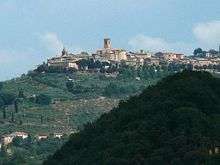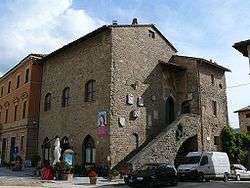Bettona
| Bettona | ||
|---|---|---|
| Comune | ||
| Comune di Bettona | ||
|
Bettona | ||
| ||
 Bettona Location of Bettona in Italy | ||
| Coordinates: 43°01′09″N 12°29′04″E / 43.01917°N 12.48444°ECoordinates: 43°01′09″N 12°29′04″E / 43.01917°N 12.48444°E | ||
| Country | Italy | |
| Region | Umbria | |
| Province / Metropolitan city | Perugia | |
| Frazioni |
Colle, Passaggio, Cerreto, I Barbini, La Palazzetta-Zona Industriale, Malandruge, Prigionieri, Taglioni, Torte | |
| Government | ||
| • Mayor | Lamberto Marcantonini | |
| Area | ||
| • Total | 45 km2 (17 sq mi) | |
| Elevation | 353 m (1,158 ft) | |
| Population (2003) | ||
| • Total | 3,855 | |
| • Density | 86/km2 (220/sq mi) | |
| Demonym(s) | Bettonesi | |
| Time zone | CET (UTC+1) | |
| • Summer (DST) | CEST (UTC+2) | |
| Postal code | 06084 | |
| Dialing code | 075 | |
| Patron saint | Saint Crispoldus | |
| Saint day | May 12 | |
| Website | Official website | |
Bettona (Latin: Vettona) is an ancient town and comune of Italy, in the province of Perugia in central Umbria at the northern edge of the Colli Martani range. It is 5 km (3 mi) E of Torgiano and 12 km (7 mi) SW of Assisi.
Passaggio, Colle and Cerreto are frazioni of the comune.
History
The town is of Etruscan origin; its people are first referred to in Pliny, NH III.114 (Vettonenses), then in other ancient authors and inscriptions.

Bettona was once the seat of a bishopric. While legend associates two other bishops with the see, the only historically documented one is Gaudentius, who took part in a synod at Rome called by Pope Hilarius in 465.[1][2]
Under the Latin name Bettonium the bishopric is listed by the Catholic Church as a titular see.[3]
Main sights
Bettona still retains a complete circuit of medieval walls incorporating substantial portions of the original Etruscan walls.
The Pinacoteca Comunale in the Palazzetto del Podestà (1371) has a painting by Pietro Perugino, the Madonna of Mercy, as well as other works by Jacopo Siculo, Dono Doni, Fiorenzo di Lorenzo and Della Robbia.
Santa Maria Maggiore church, situated in the historical centre, is the main church of the region of Bettona. The Gothic chapel, dedicated to Saint Rita, is the only remaining part of the Roman church. The main altar is in the shape of domed temple, by Cruciano Egiduzio. The apse was frescoed in 1939 by the futurist painter Gerardo Dottori.
The church of San Crispolto was erected by monks to preserve the body of the patron saint (8th century). The current façade is by Antonio Stefanucci.
In the “Oratorio of St. Andrea” is a series of paintings from the school of Giotto, dated 1394, which show the Passion of Christ.
The town is also locally noted for its walled gardens.
References
- ↑ Francesco Lanzoni, Le diocesi d'Italia dalle origini al principio del secolo VII (an. 604), vol. I, Faenza 1927, pp. 427–434
- ↑ Giuseppe Cappelletti, Le Chiese d'Italia della loro origine sino ai nostri giorni, vol. V, Venezia 1846, pp. 190–193
- ↑ Annuario Pontificio 2013 (Libreria Editrice Vaticana 2013 ISBN 978-88-209-9070-1), p. 849
External links
| Wikimedia Commons has media related to Bettona. |
- Bettona official site, also in English
- Bill Thayer's site
(Based on the page in Bill Thayer's Gazetteer of Umbria, by permission.)

